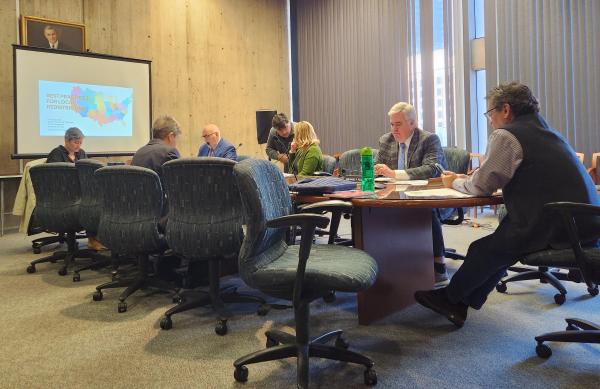October 21, 2022

Under the watchful portrait of James Michael Curley, councillors get ready to hold a Friday "working session" on redistricting, the once-in-a-decade redrawing of the city's political boundaries. (Gintautas Dumcius photo)
City councillors have five maps in their hands as they seek to redraw the political boundaries of the nine districts. But they still haven’t fully decided which route they want to take.
Most of the 13-member Council met on Friday inside City Hall for nearly four hours, hearing from a Tufts University expert on redistricting and taking a knife to districts as a portrait of James Michael Curley, the former mayor and governor known as the “Rascal King” who once dominated Massachusetts politics, looked on.
The once-in-a-decade redistricting process has heightened tensions between councillors as they grapple with reworking the nine council districts. South Boston-based District 2, Dorchester-based District 3, and District 4, made up of both Dorchester and Mattapan, are set to go under the knife due to a population boom in District 2’s Seaport neighborhood and a loss of population in District 3. The four councillors elected citywide also have a say in which map heads to Mayor Michelle Wu’s desk.
A map backed by the Boston branch of the NAACP and other advocacy groups is said to have at least seven votes. But the lone Black man on the Council, Brian Worrell of District 4, raised the question on Friday whether it weakens Black votes by pulling in high-voting white precincts from Dorchester’s Neponset area.
Friday’s meeting also saw several councillors, sensing some momentum behind the NAACP map, push for a delay in a vote that could occur at the City Council meeting scheduled for Wednesday, Oct. 26.
“I think the thing we should do is hit the brakes and set a date a month out,” District 3 Councillor Frank Baker, who has his own map and opposes the Neponset shift, said to Liz Breadon, the chair of the redistricting committee and the district councillor for Allston-Brighton.
Breadon said a year is needed between the map being passed into law and next year’s municipal election. District candidates for City Council must live in the district a year before the election.
But Baker said Nov. 7, the deadline bandied about throughout the process for passing a map into law, is arbitrary.
District 2 Councillor Ed Flynn, who is also the City Council president, agreed with the call for a slowdown, as did Councillor At-Large Erin Murphy. “I would rather get it done right than get it done now,” Flynn said.
But District 8 Councillor Kenzie Bok, Councillor At-Large Julia Mejia and District 5 Councillor Ricardo Arroyo said they should move towards a final map sooner rather than later. Arroyo said delaying past the Nov. 7 deadline feels like ”incumbency protection,” to stall candidates who may be thinking about a candidacy in the next couple of months.
After the meeting, Worrell, who is the vice chair of the redistricting committee, said a vote on Wednesday remains possible, as long as councillors’ working sessions are productive, and they’re taking in community input and considering Black voting numbers in majority-minority districts.
“All of these maps are works in progress,” he said of the five proposals before councillors.
Whether maps weaken Black votes by adding white voters to districts should be taken into consideration, according to Worrell, who noted ongoing gentrification and Black people leaving Dorchester at a high rate.
“If people feel it doesn’t (weaken black votes), then show us the numbers so we can understand the impacts it has on our ability to elect candidates of choice,” he said. “In this moment in time we should not be weakening Black votes.”
During the meeting, District 2’s Flynn suggested precincts he would be willing to give up in an effort to get to a final map. They included the ones around the Prudential Center and the Hynes Convention Center.
The councillors also heard from Moon Duchin, a math professor at Tufts University and an expert in redistricting. She runs the lab that built one of the mapping tools councillors are using in their efforts.
Duchin said their five maps have more similarities than differences.
Councillors also took away from her talk that the effectiveness of a district's Black vote is an important factor, not so much the percentage of the population within a certain district. Population numbers within a district, on their own, do not necessarily indicate voting patterns.
Mejia asked if redistricting has taken a personal turn in Boston, as councillors have scrapped over which neighborhoods to divide.
“I mean, have you been following LA?” Duchin said, referring to the recent outrage over Los Angeles Councilwoman Nury Martinez, the first Latina to hold the job, and leaked audio of remarks that denigrated Blacks, Jews, and indigenous Mexicans. Martinez resigned earlier this month.
"The light and heat around redistricting this cycle is intense,” Duchin said.
The intensity was evident in the Curley Room a short while later. Even as councillors appeared to make some headway in identifying precincts to shift between their respective districts, tensions flared.
At one point, when Baker finished talking about keeping the Cedar Grove neighborhood united and Arroyo began to make remarks, Baker broke in and said to him, "What are you smirking at? You're laughing at something."
"Relax when you're talking to other people,” Arroyo responded. “I wish you peace."
“You're laughing and smirking after I finished talking,” Baker said.
Breadon sought to calm the situation down. “Please. We need to treat each other with respect and we need to do the work.”
“We need an extension to do the work,” Baker said as Arroyo resumed his remarks.


